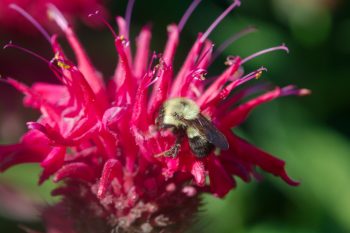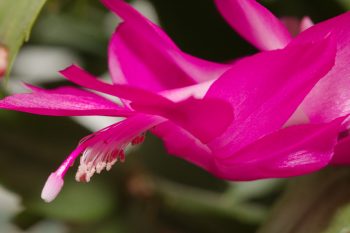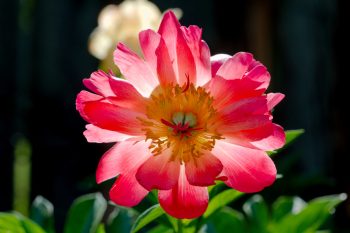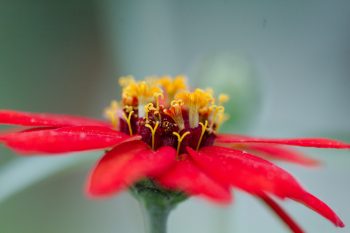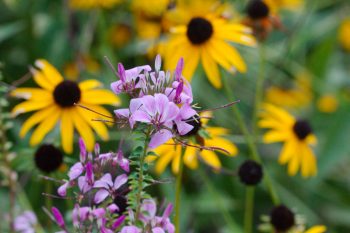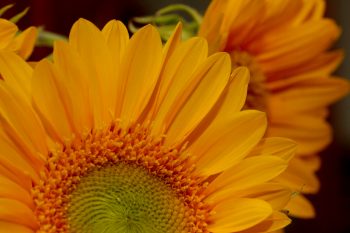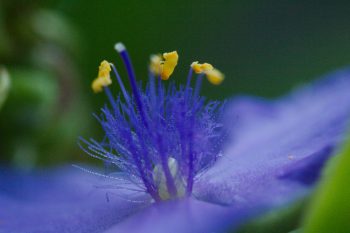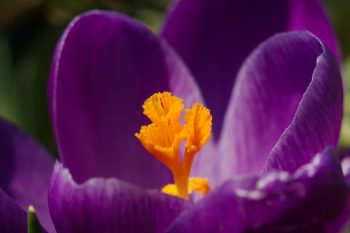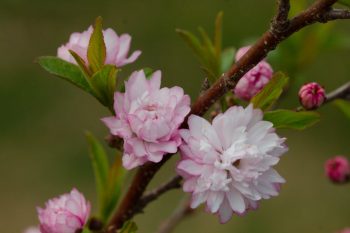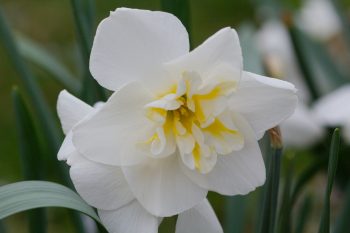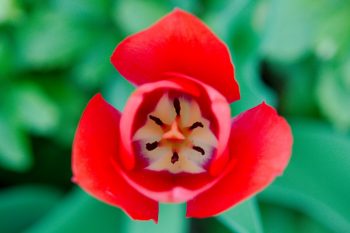I sat on the patio for a while this afternoon, just enjoying being in the sun. It was actually a little hot for my taste, but still nice for all of that. Also, the light is better for macro photography in the sun, when you want as much depth of field and as fast a shutter speed as possible. I was watching the insects around the potted flowers on the patio and got a few pictures of this skipper (family Hesperiidae) on a coreopsis (a.k.a. tickseed) flower. The insects aren’t around it the huge numbers we’ll have in a few weeks, particularly when the mountain mint (Pycnanthemum muticum) starts to bloom, but they are certainly here and I really enjoy them.
Tagged With: Bloom
Skipper on Coreopsis
Bumble Bee Balm
I’ve been able to get a fair number of flower pictures so far this year but the insects are not out in all their force yet. I’ve seen many around but haven’t been able to photograph many of them. This is my first bumble bee of the summer. It isn’t the best bumble bee picture I’ve ever taken but it makes me happy, with the brightness of the bee balm (Monarda didyma) contrasting with the black of the common eastern bumble bee (Bombus impatiens). I’m sure there will be many more to come. As for the title of this post, it’s the sort of thing that shows up in crossword puzzles fairly often, two words or phrases that overlap in the middle. Bumble Bee and Bee Balm.
Zinnia
When we moved into our house 11 years ago there was a large oak tree centered at the front of the property. It was not a healthy tree and was in the slow process of dying. Because it was actually in the road right-of-way, the county came (at our request) and took it down. Since then Cathy has planted mostly annuals every spring in the spot where it used to be. These are generally brightly colored zinnias and marigolds, although there are other plants as well as a few containers with even more variety. This is the flower from one of the zinnias.
Dahlia ‘Dracula’
I posted a picture of this same dahlia on Monday, September 18, 2017, so you’ll have to excuse the repetition. Although it’s not particularly large for a dahlia flower, it’s very pretty. Also, the plant has very dark purple, not-quite-black foliage. It’s lovely overall and we definitely need to dig up the tuber and try to keep it for next year. We’ve never actually done that before and I’m not sure how successful we’ll be. They are supposed to be stored in a damp place all winter in temperatures that are between 45°F and 50°F, which is a pretty narrow range and not something we have naturally in our house. Our basement is cool but not that cool and we do our best to make it dry, not humid (it’s currently at 38% relative humidity). So, we’ll see what we can do.
Schlumbergera truncata (Thanksgiving Cactus)
Our Thanksgiving cactus (Schlumbergera truncata) is blooming right on schedule this year. It’s such a cheerful color to brighten up the kitchen and I’m happy for it. It’s a fairly unassuming plant most of the year but as with many cacti, its flowers are remarkable. We have a half dozen of them and some are doing better than others but they are relatively easy plants, not asking for a lot of attention, which is good, because they really don’t get much from us. And yet, this is what they give us.
Star Magnolia Bud
The house Cathy grew up in has two star magnolias (Magnolia stellata) in the front yard. They bloom early and their petals are quite tender so it’s actually more common for them to be frost damaged than not. The snow and cold we had yesterday has done a little damage to the petals, as you can see on this bud. Nevertheless, if it doesn’t get cold again, this tree could put on a wonderful show in a week or so. But we aren’t out of the woods yet, in terms of frost and there’s plenty of time for these blooms to be wiped out. They’re lovely as they are, of course, but on the rare occasion the trees bloom without any petal burn, they are quite spectacular.
Camellia japonica ‘Pink Perfection’
Some things are worth waiting for. If they were not, we’d have a hard time planning for anything farther away than next week, I guess. Some things, like trees and to a lesser extent shrubs, take a while to be worth planting. In the spring of 2010, I planted a small Camellia japonica called ‘Pink Perfection’. It was small to begin with and struggled through the first couple years. I’ve lowered the pH of the soil around it, and that seems to have helped significantly. It bloomed a few times the first year but hasn’t bloomed since until now. Hopefully it is becoming well enough established that it will begin to grow and we’ll get more like this in the years to come.
Peony ‘Coral Sunset’
In the fall of 2014 I bought three peonies called ‘Coral Sunset’ from John Scheepers (https://www.johnscheepers.com/). I planted them amidst the pachysandra along the back of my garden. The first spring there was only evidence of one of them. The next year, two. Now all three are coming up through the pachysandra and each of them bore a single bud. This is the largest and the first of them to bloom. I must say, they are worth the wait. One great thing about peonies is that they are long lived and they continue to grow into larger and larger clumps. These three should eventually grow together into one massive clump that will be wonderful in bloom. For now, I enjoy the solitary flower.
Peony ‘Coral Sunset’
I know I’ve already posted a picture of this plant this spring. In fact, it was only four days ago. Nevertheless, The second of the three peonies that I planted in 2014, named ‘Coral Sunset’, was blooming and had the late afternoon sun shining through it. I just couldn’t resist another picture of this wonderful flower. With one bloom per plant, we’re basically done for the year with these three. But they were worth it and I’m already looking forward to a total of four or five flowers on the three plants next year.
Zinnia
It was another foray out onto the driveway for pictures this evening after work. Today was relatively quiet, coming home from work and not going out again, which was a treat after the week we’ve had. Things will get busy again tomorrow as William and Beth are driving down from New York and we’ll be going through a few things in the basement at Margaret’s house. I stopped at the store and bought some ground beef and ground pork. When I got home I made some meat sauce to have with tortellini and also made a meat loaf to slice and reheat for meals in upcoming days.
Deep Orange Zinnia
In the small garden where the county once had an oak tree, down by the road, Cathy has been growing mostly annuals each summer. We got a lot less done in the yard this year but she did manage to get a bunch of zinnia and marigold plants in the ground. There is Pachysandra terminalis already growing around the bed but she has kept the center, where the tree was, clear for her annuals. There is also Conoclinium coelestinum (Blue Mistflower), a slightly invasive herbaceous perennial, but she pulls out enough each year to keep things balanced. The blue of the Conoclinium goes well with the yellow and orange of the zinnias and marigolds.
Cleome and Black-eyed Susan
We really should plant more of this. The pink flowers in the foreground are Cleome ‘Señorita Rosalita’ and they really are lovely. They also bloom pretty much continuously all summer and well into the fall. We have just a few plants growing in a container on the back patio. They are pretty much overwhelmed by the yellow of the black-eyed Susans that are all around. I think if we had a larger container or two filled with Cleome, it would be pretty nice. I should make a point of buying a few packets of next year and getting them started early.
Sunflowers
These were given to Margaret for her 92nd birthday and are quite pretty. We have them in a tall, blue vase that we were given as a wedding present and they are photographed here in front of the cherry china cabinet that I’ve used as a backdrop a few times since we moved it to our dining room. Sunflowers are great, not just because they last so long in a vase, but that certainly is a useful trait. Their combination of ray petals and the small flowers that make up the center of the flower head are just really pretty. And the color is nice, too.
Anthurium andraeanum
The Anthurium genus contains about 1000 species—the largest genus in the arum family—but only two of them are grown for their bright red spathes. This is Anthurium andraeanum, a native to Colombia, Ecuador, Venezuelan Antilles, and the Windward Islands. Common names include flamingo lily and painter’s palette, although I’ve only ever known it simply as Anthurium. Like many plants in the Araceae family, Anthurium species contain calcium oxalate crystals (CaC2O4(H2O)x) and are therefore poisonous to humans. They’re pretty, though.
Tradescantia virginiana (Spiderwort)
This spiderwort (Tradescantia virginiana) is growing right outside our kitchen door and although it doesn’t have so many flowers at this time of the year, it still manages to put out a few. They are such beautiful little flowers and I can’t imagine not having them in our garden. The color ranges from blue to purple and it’s not always the same in photographs as it is to the eye. It’s possible that some of the color comes from the physical structure of the flower rather than from a pigment but I don’t actually know for sure. Examples of structural colors include those found in peacock feathers, butterfly wings, and the beautiful iridescence of beetle carapaces. If you are interested in structural colors, you might find this article interesting: Color from Structure in The Scientist.
Crocus
The so-called Dutch crocus (Crocus vernus and its cultivars) is native to the mountains of Europe, the Pyrenees, Alps and Carpathians. The name crocus comes from krokos (κρόκος) the ancient Greek name for saffron (Crocus sativus). While crocuses prefer gritty, well-drained soils they do amazingly well in our heavy, clay soil that is totally water logged all winter most years. This one is growing in a bed of lily of the valley (Convallaria majalis) and Vinca minor in our back yard. There are also some daffodils and hyacinths that are starting to come up bu those won’t be in bloom for a little while yet.
Windflower (Anemone blanda)
Last Sunday after church we walked to the Stadtman Preserve and I posted a picture of three little Chionodoxa forbesii blossoms. This week we went there again. The daffodils are starting to bloom and there are lots more Chionodoxa flowers opening up throughout the property. It was this little windflower (Anemone blanda) that really caught my eye. It’s such a pretty little thing. I’ve had a few of them in our garden but they never really amounted to much. I need to make a note to myself to buy a bunch of them and put them in. Interestingly, the flower is apetalous (it has no petals) and what look like petals are actually sepals.
Flowering Almond
We have this little flowering almond shrub in our front garden near the corner of our garage. It never gets very big because it’s not entirely hardy here and every couple years it dies back pretty hard. We actually had a few days when the temperature was nearing 0°F (-18°C) but it seems to have come through it practically unscathed. The flowers, clustered around the stems, are fairly small, only a half inch or so across. Never the less, they are quite pretty, both individually and as a whole. It’s really a shame this doesn’t get bigger because it would be spectacular.
Narcissus ‘Lemon Beauty’
The daffodils are about at their peak right now and will soon begin to fade. We have a few that are still getting ready to bloom for for the most part, they are open. These ‘Lemon Beauty’ daffodils were planted in the fall of 2014 so this is their fifth spring and they are doing quite well. They were planted in the bed around the Colorado spruce and were somewhat shaded by that but now that it’s gone, they’ll get more early spring sun, which they will appreciate, I suspect. The stump of the spruce is still there and I need to finish getting that up and then decide what to plan in its place. I’ve narrowed it down to a half dozen flowering trees but making the final decision is hard.
Tulip ‘Van Eijk’
In the fall of 2009 and again in 2010 I bought a pretty good number of bulbs from McClure and Zimmerman (https://www.mzbulb.com/). In each of those orders they threw in five tulip of the variety ‘Van Eijk’. There are still ten plants growing where I planted them although we only have six blooms this year. Tulips are not terribly long-lived plants, certainly not in our area, anyway, so the fact that these are still blooming after 8 or nine years is pretty good. They’re quite bright and a sea of them would be more impressive than the six I have, of course. In general, though, I’m more a fan of daffodils, which seem to live forever and form large clumps over time.


